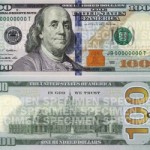New $100 Bill Hard To Replicate
Two years after it was supposed to be released to the banks, the new $100 bill was introduced recently by the Federal Reserve. The Fed announced three years ago that an issue in the latest security measures of the currency caused the bills to fold. Due to this, the bills had a number of blank spaces.
Since the budget of the Fed was not included in the congressional appropriations impasse, the government shutdown did not play any role in the late introduction of the bill.
A number of features on the new $100 bill will allow the public to easily authenticate it. However, it will not be easy to replicate by counterfeiters. Among the features are the blue, 3D security ribbon and color-shifting ink. The ink, which is located on the big “100” at the back, changes to green from copper when the bill is tilted. It is also found on a “100” in front of the new $100 bill.
Although the Benjamin Franklin image on the new bill is similar to the present bill, the dark oval will be removed. Nearly all of the paper currency of the US was redesigned during the last decade to fight counterfeiting. The only paper currency that did not undergo any changes were the $1 and the $2 bill.
The $1 bill is the most common paper currency bill in circulation with the $100 coming in at second. Around 8.6 billion pieces of $100 bills are in currently in circulation compared to the 10.3 billion pieces of $1 bills. Around 75 percent of the $1 trillion worth of US paper currency in circulation is made up of $100 bills.
The current $100 bill will still be considered as legal tender and customers are still expected to receive them from the bank. However, banks are set to receive the new $100 bill from now on from the Federal Reserve.
